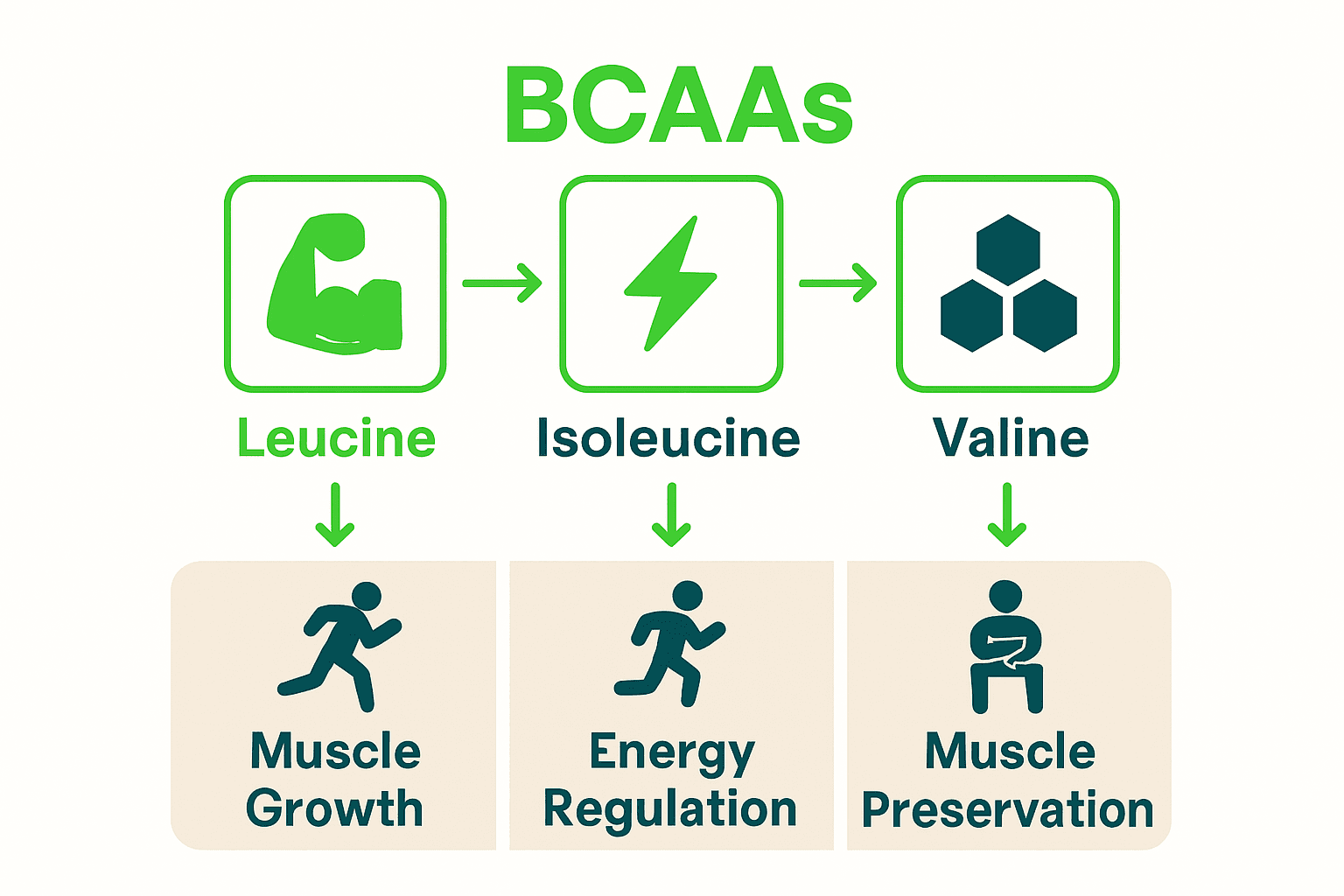Did you know that over 35 percent of the essential amino acids in muscle protein come from branched-chain amino acids? Many athletes rely on BCAAs to recover faster and improve performance, but these nutrients do much more than fuel workouts. Their unique ability to be absorbed right in your muscles means they can support muscle building, reduce soreness, and help you maintain lean tissue when it matters most.
Table of Contents
- What Are Branched Chain Amino Acids?
- Main Types of Branched Chain Amino Acids
- How BCAAs Support Muscle Growth and Recovery
- Best Practices for BCAA Supplementation
- Potential Risks and Side Effects of BCAAs
Key Takeaways
| Point | Details |
|---|---|
| BCAAs Overview | Branched-chain amino acids (BCAAs) consist of leucine, isoleucine, and valine, essential for muscle metabolism and recovery. |
| Functionality | Each BCAA has unique roles: leucine triggers protein synthesis, isoleucine regulates energy, and valine prevents muscle breakdown. |
| Supplementation Timing | BCAA intake should occur pre-, during, and post-exercise for optimal results, generally within 30 minutes of training sessions. |
| Potential Risks | Common side effects may include digestive issues and coordination impairment; consult healthcare professionals before starting supplementation. |
What Are Branched Chain Amino Acids?
Branched-chain amino acids (BCAAs) are a unique group of essential nutrients that play a crucial role in muscle metabolism and protein synthesis. According to bmcmedgenomics, these amino acids are characterized by their distinctive branched molecular structure and include three primary components: leucine, isoleucine, and valine.
Unlike other amino acids, BCAAs are primarily metabolized directly in muscle tissue rather than being processed through the liver. This unique characteristic makes them especially important for athletes and fitness enthusiasts seeking optimal muscle recovery and performance. The branched structure allows these amino acids to be rapidly absorbed and utilized by muscle cells, providing a quick source of energy and supporting muscle protein synthesis.
The three specific BCAAs each serve distinct functions in the body:

- Leucine: Primary driver of muscle protein synthesis, triggers muscle growth mechanisms
- Isoleucine: Supports energy regulation and muscle metabolism
- Valine: Helps prevent muscle breakdown during intense physical activity
For individuals engaged in regular strength training or endurance sports, understanding the role of BCAAs can be a game-changer in optimizing fitness performance. These essential amino acids are not produced naturally by the human body, which means they must be obtained through dietary sources or supplementation.
Main Types of Branched Chain Amino Acids
Branched-chain amino acids (BCAAs) consist of three essential amino acids with unique molecular structures and critical roles in muscle metabolism. According to bmcmedgenomics, these three primary BCAAs are leucine, isoleucine, and valine, each with distinctive characteristics that contribute to protein synthesis and energy metabolism.
Leucine stands out as the most prominent BCAA, acting as a primary trigger for muscle protein synthesis. It activates a critical metabolic pathway called the mTOR (mammalian target of rapamycin), which essentially signals muscle cells to initiate growth and repair processes. For athletes and fitness enthusiasts, leucine represents the most potent amino acid for muscle development and recovery.
Isoleucine plays a crucial role in energy regulation and glucose uptake. Unlike leucine, isoleucine specializes in supporting muscle metabolism by helping muscles utilize glucose during intense physical activities. It assists in preventing muscle fatigue and supports energy production, making it particularly valuable for endurance athletes.
Valine, the third BCAA, focuses on muscle tissue preservation and preventing muscle breakdown during strenuous exercise. It works synergistically with leucine and isoleucine to maintain muscle integrity, support muscle repair, and provide additional energy substrate during prolonged physical activities.
To fully leverage the potential of these amino acids, many athletes turn to comprehensive amino acid guides that detail optimal supplementation strategies. Understanding the unique roles of leucine, isoleucine, and valine can significantly enhance your approach to muscle recovery and performance enhancement.
Here’s a summary of the unique roles and functions of each BCAA:

| BCAA | Primary Function | Key Benefit for Athletes |
|---|---|---|
| Leucine | Triggers protein synthesis | Muscle growth and repair |
| Isoleucine | Regulates energy and glucose use | Supports endurance and muscle metabolism |
| Valine | Prevents muscle breakdown | Maintains muscle integrity during exercise |
How BCAAs Support Muscle Growth and Recovery
Branched-chain amino acids (BCAAs) play a critical role in muscle development and recovery, offering athletes and fitness enthusiasts a powerful tool for optimizing physical performance. Research from the University of Birmingham demonstrates that co-ingesting BCAAs with carbohydrates post-exercise can significantly stimulate myofibrillar protein synthesis, particularly in trained individuals.
The mechanism behind BCAA-supported muscle growth is primarily driven by leucine, which activates the mTOR (mammalian target of rapamycin) pathway. This biochemical process triggers muscle protein synthesis, essentially telling muscle cells to initiate growth and repair mechanisms. By reducing muscle protein breakdown during intense training and providing the essential building blocks for muscle reconstruction, BCAAs help athletes maintain and develop lean muscle mass more effectively.
Key benefits of BCAA supplementation for muscle recovery include:
- Reduced Muscle Soreness: Minimizes exercise-induced muscle damage
- Faster Recovery: Accelerates muscle repair processes
- Enhanced Protein Synthesis: Provides critical amino acids for muscle building
- Energy Production: Supports muscle metabolism during prolonged activities
For athletes looking to maximize their muscle growth and recovery strategies, BCAA supplementation techniques can be a game-changing approach.
By understanding how these amino acids work synergistically, individuals can optimize their nutritional intake to support intense training regimens and achieve superior muscle development results.
Best Practices for BCAA Supplementation
BCAA supplementation requires strategic planning to maximize muscle recovery and growth potential. Research from the University of Birmingham highlights the critical importance of combining BCAA intake with carbohydrates post-exercise to enhance muscle protein synthesis, particularly for trained athletes and fitness enthusiasts.
Timing is crucial when incorporating BCAAs into your nutritional strategy. Most sports nutrition experts recommend consuming BCAAs in three primary windows: before exercise to prevent muscle breakdown, during prolonged training to maintain energy levels, and immediately after workout to support muscle recovery. The typical recommended dosage ranges between 5-10 grams per serving, depending on body weight and intensity of physical activity.
Key best practices for effective BCAA supplementation include:
- Pre-Workout: Consume 5-7 grams 30 minutes before training
- During Exercise: Take 3-5 grams to maintain muscle integrity
- Post-Workout: Ingest 5-10 grams within 30 minutes after completing exercise
- Combine with Carbohydrates: Enhance absorption and muscle protein synthesis
- Maintain Consistency: Regular supplementation yields better results
For athletes seeking to optimize their supplementation approach, performance enhancement strategies can provide additional insights into maximizing nutritional effectiveness. Remember that individual responses to BCAAs can vary, so monitoring your body’s adaptation and consulting with a sports nutritionist is recommended for personalized guidance.
Potential Risks and Side Effects of BCAAs
BCAA supplementation, while generally beneficial for athletes and fitness enthusiasts, is not without potential risks and side effects. According to WebMD, these supplements can cause various physiological responses that individuals should carefully consider before incorporating them into their nutritional regimen.
The most commonly reported side effects include gastrointestinal discomfort and neurological impacts. Users might experience symptoms such as nausea, diarrhea, and bloating, which can be particularly uncomfortable during intense training periods. More critically, BCAAs can potentially affect motor coordination, creating potential risks during activities that require precise physical control, such as driving or operating machinery.
Potential side effects and risks include:
- Digestive Issues: Nausea, bloating, and diarrhea
- Coordination Impairment: Reduced motor skills and reaction times
- Fatigue: Unexpected energy level fluctuations
- Potential Allergic Reactions: Rare but possible in sensitive individuals
- Insulin Sensitivity: May impact blood sugar regulation
For athletes seeking comprehensive understanding of supplement safety, best amino acids for recovery resources can provide additional insights. Always consult healthcare professionals before starting any new supplementation regime, particularly if you have pre-existing medical conditions or are taking other medications.
Unlock Your Muscle Potential with Targeted BCAA Support
If you are struggling with muscle soreness, slow recovery, or stalled performance despite regular training, understanding and using the right branched chain amino acids can transform your results. This article highlights how leucine, isoleucine, and valine work together to support muscle protein synthesis, reduce breakdown, and enhance energy during workouts. These essential amino acids are critical for anyone serious about muscle growth and endurance but must be obtained through diet or supplementation.

Take control of your fitness journey today by exploring premium BCAA supplements and tailored nutritional products at MyGymSupplements.shop. Whether you want to improve recovery speed, boost energy, or build lean muscle, our range is designed to support your goals effectively. Don’t wait to unlock your full muscle-building potential. Visit MyGymSupplements.shop now and discover how easy it is to enhance your performance with essential amino acids and more.
Frequently Asked Questions
What are branched-chain amino acids (BCAAs)?
Branched-chain amino acids (BCAAs) are essential nutrients that include leucine, isoleucine, and valine. They play a crucial role in muscle metabolism and protein synthesis, primarily metabolized in muscle tissue rather than the liver.
How do BCAAs benefit muscle growth and recovery?
BCAAs, particularly leucine, stimulate muscle protein synthesis and reduce muscle breakdown. They help minimize soreness, accelerate recovery, and provide essential amino acids for muscle building post-exercise.
What is the recommended timing for BCAA supplementation?
It is advised to take BCAAs before, during, and after workouts. A typical dosage is 5-10 grams per serving, consumed 30 minutes prior to exercise, during prolonged training, and within 30 minutes after completing the workout.
Are there any side effects associated with BCAA supplementation?
Yes, potential side effects of BCAAs include digestive issues such as nausea and diarrhea, coordination impairment, fatigue, and rare allergic reactions. It’s important to consult a healthcare professional before starting supplementation.



0 comments